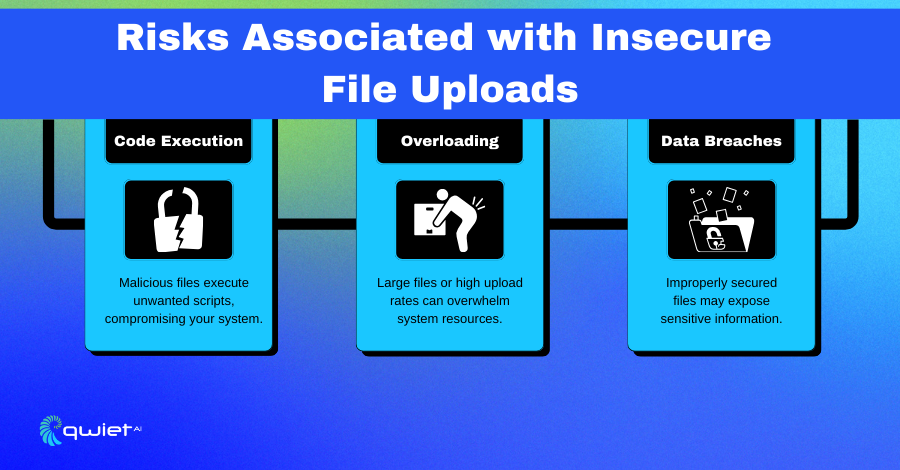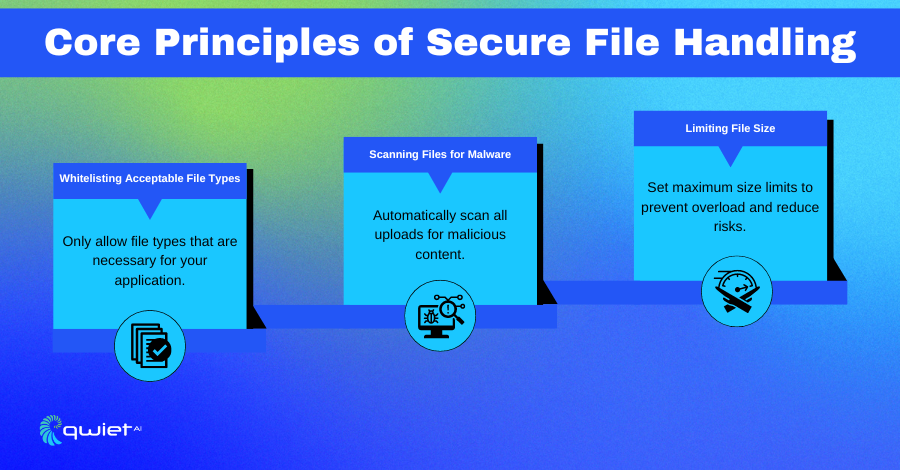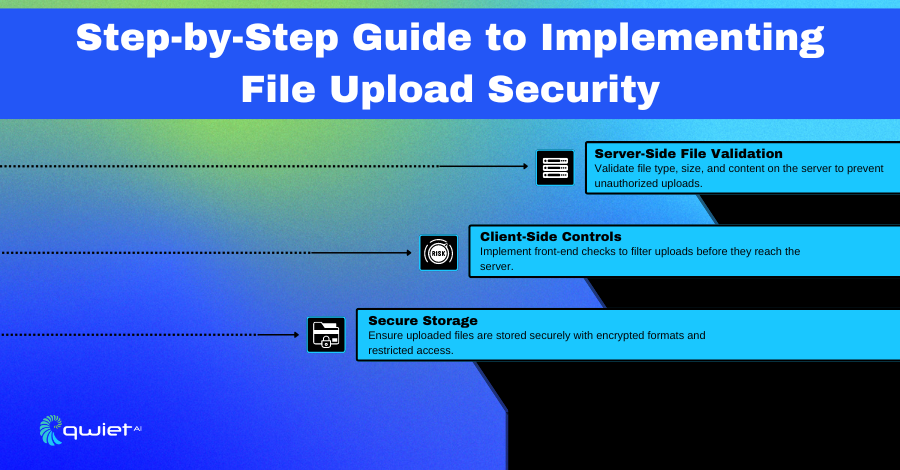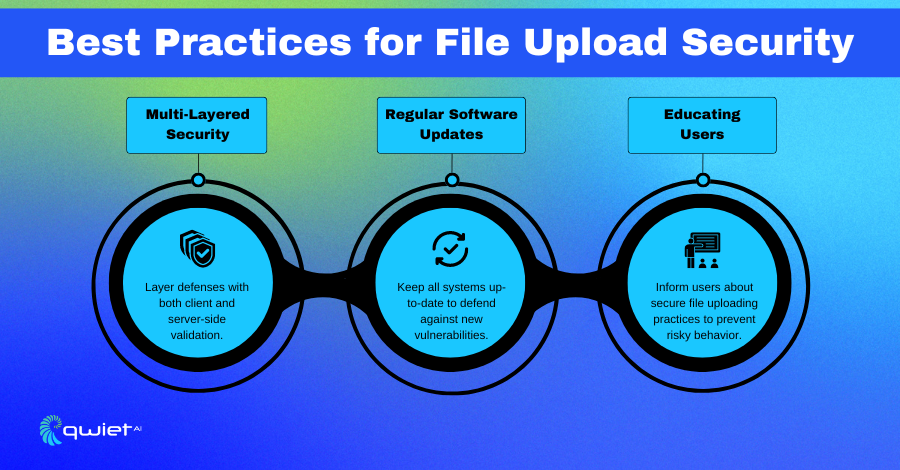What is File Upload Security?
File upload security refers to the protocols and measures to ensure that files uploaded to web applications do not compromise the system’s security or expose sensitive information. These measures are crucial because they defend against unauthorized access and malicious activity from compromised file uploads.
Developers should prioritize these security practices to maintain the integrity and confidentiality of the data handled by applications, which often include personal, financial, or proprietary information.
The necessity of file upload security arises from the potential for uploaded files to serve as a gateway for cyber threats. Without stringent checks, malicious actors can upload harmful files that exploit vulnerabilities, leading to unauthorized system access or data theft.
Implementing effective file upload security involves validating file types, scanning for malware, and controlling file sizes, all aimed at mitigating the risk of these uploads becoming security liabilities.
Risks Associated with Insecure File Uploads

Code Execution:
Malicious files can execute unwanted scripts or software within an application, leading to unauthorized actions or access. For example, an attacker could upload a seemingly benign image file embedded with a script that executes when the file is processed by the server.
| document.getElementById(‘upload’).addEventListener(‘change’, function(event) { const file = event.target.files[0]; if (file.type !== ‘image/jpeg’) { alert(‘File must be a JPEG image.’); return; } const reader = new FileReader(); reader.onload = function(e) { const img = new Image(); img.src = e.target.result; img.onload = function() { checkImage(this); }; }; reader.readAsDataURL(file); }); function checkImage(image) { // Logic to check if the image contains executable scripts } |
The code snippet above outlines a client-side check for file uploads, ensuring only JPEG images are processed. However, more is needed to secure uploads since JavaScript checks can be bypassed.
Malicious scripts hidden in the image’s metadata could still execute if not properly handled server-side. Therefore, thorough server-side validation and sanitization are necessary to prevent executing hidden scripts.
Overloading:
Large or numerous file uploads can overwhelm system resources, potentially leading to slowed services or even a denial-of-service (DoS) attack. Attackers might exploit this by uploading large files or flooding the server with too many files, thereby exhausting server bandwidth, storage, or processing capacity.
| const form = document.getElementById(‘file-upload-form’); form.onsubmit = function(event) { event.preventDefault(); const files = document.getElementById(‘file-upload’).files; if (files.length > 5) { alert(‘Upload limit is 5 files.’); return; } this.submit(); }; |
The snippet prevents users from uploading more than five files simultaneously, aiming to mitigate resource exhaustion risks. However, it’s crucial to complement client-side checks with server-side constraints, such as capping the size and number of files processed within a certain timeframe, to shield against overloading effectively.
Data Breaches:
Insecure file uploads can expose sensitive information either directly through the files uploaded or by enabling further exploitation of the system’s vulnerabilities.
| document.getElementById(‘upload’).addEventListener(‘change’, function(event) { const file = event.target.files[0]; const reader = new FileReader(); reader.onload = function(e) { if (e.target.result.includes(‘sensitiveKeyword’)) { alert(‘Sensitive content detected.’); return; } // Proceed with file upload }; reader.readAsText(file); }); |
This example showcases a basic attempt to detect sensitive information within text files before uploading. However, this approach is quite limited and does not replace the need for robust server-side scanning and validation.
To protect against data breaches, uploaded files should undergo comprehensive checks for sensitive content and potential threats, ensuring they do not compromise the application’s security.
Core Principles of Secure File Handling

Whitelisting Acceptable File Types:
Restricting file types by whitelisting acceptable formats is critical in defending against security threats from file uploads. By allowing only files with certain extensions, you effectively block many vectors for uploading malicious content, such as executable files or scripts disguised within other file types. This approach is not just about blocking known bad types; it’s about allowing only known good types, thereby reducing the attack surface available to potential attackers.
| document.getElementById(‘file-upload’).addEventListener(‘change’, function(event) { const allowedExtensions = [‘jpg’, ‘png’, ‘pdf’]; const file = event.target.files[0]; const fileExtension = file.name.split(‘.’).pop().toLowerCase(); if (!allowedExtensions.includes(fileExtension)) { alert(‘This file type is not allowed.’); return; } // Proceed with file upload }); |
The script adds an event listener that checks the file extension when a user attempts to upload a file. If the file extension isn’t included in the list of allowed types, the upload is stopped immediately, and the user is notified through an alert. Implementing this check helps prevent the uploading of files that could potentially execute harmful scripts if processed by the server.
However, similar server-side checks must support this client-side validation to provide a strong defense, as a determined attacker can bypass client-side validations.
Use SAST Tools to scan your codebase
Integrating Static Application Security Testing (SAST) tools like Qwiet into the development lifecycle can greatly enhance the security of file upload functionalities. SAST tools analyze the source code statically (without executing the code) to identify vulnerabilities that could be exploited once the application runs. These tools are particularly effective in identifying complex security issues such as injection flaws, insecure dependencies, and other common vulnerabilities that could affect file upload features.
Using SAST tools is beneficial for immediate vulnerability detection and ensuring compliance with coding standards and security best practices throughout development.
By incorporating these tools, developers can address security issues at the earliest stages, reducing the risk of costly and damaging breaches in the future.
Limiting File Size
Implementing file size limits is a straightforward yet effective control to prevent server resource exhaustion, which can be caused by the uploading of excessively large files. This type of control is essential in environments where the server’s resources, such as bandwidth, memory, and processing power, are finite and can be significantly impacted by large uploads. By enforcing size limits, the application can avoid performance degradation and reduce the risk of denial-of-service (DoS) attacks, where attackers intentionally upload large files to disrupt service.
| document.getElementById(‘file-upload’).addEventListener(‘change’, function(event) { const maxFileSize = 10485760; // 10MB const file = event.target.files[0]; if (file.size > maxFileSize) { alert(‘File size exceeds the 10MB limit.’); return; } // Proceed with file upload }); |
This code snippet showcases a preventive measure against large file uploads by limiting the maximum file size. If the uploaded file exceeds the predefined size, the upload is halted, and the user is immediately informed.
While this control helps prevent strain on server resources and guards against simple DoS attacks, like the previously mentioned controls, it also needs to be enforced on the server side to ensure that it cannot be circumvented. This dual-layered approach—client-side for user convenience and server-side for security assurance—is fundamental in creating a robust defense against file upload-related threats.
Implementing File Upload Security

Setting up Server-Side File Validation:
Server-side validation is essential for ensuring that file uploads meet security standards, even if client-side checks are bypassed. This involves validating the file type, size, and content against defined security criteria to prevent malicious uploads. Implementing thorough server-side checks mitigates the risk of attackers exploiting client-side vulnerabilities and reinforces the overall security of the file upload process.
| const express = require(‘express’); const fileUpload = require(‘express-fileupload’); const app = express(); app.use(fileUpload()); app.post(‘/upload’, function(req, res) { let sampleFile; let uploadPath; if (!req.files || Object.keys(req.files).length === 0) { return res.status(400).send(‘No files were uploaded.’); } sampleFile = req.files.sampleFile; uploadPath = __dirname + ‘/uploads/’ + sampleFile.name; // Validate file size and type if(sampleFile.size > 2048000 || ![‘image/jpeg’, ‘image/png’].includes(sampleFile.mimetype)) { return res.status(400).send(‘Invalid file format or size.’); } // Save the file sampleFile.mv(uploadPath, function(err) { if (err) return res.status(500).send(err); res.send(‘File uploaded!’); }); }); |
The code above uses Node.js with the Express framework and ‘express-fileupload’ middleware to handle file uploads. It checks whether a file has been uploaded, validates the file size and type, and moves the file to a designated directory if these checks pass. This server-side validation is crucial as it is the last defense against inappropriate file uploads, ensuring that only files that meet strict criteria are accepted and stored.
Configuring Client-Side Controls to Reduce Unwanted File Uploads:
Client-side controls are the first line of defense in the file upload process, providing immediate feedback to users and reducing unnecessary server load by preventing the submission of invalid files.
| document.getElementById(‘file-upload’).addEventListener(‘change’, function(event) { const file = event.target.files[0]; const validFileTypes = [‘image/jpeg’, ‘image/png’]; const maxFileSize = 2000000; // 2MB limit if (!validFileTypes.includes(file.type) || file.size > maxFileSize) { alert(‘Invalid file type or file size too large.’); event.target.value = ”; // Reset the file input } else { document.getElementById(‘upload-form’).submit(); } }); |
This snippet adds an event listener to the file input element, checking the file type and size when the user selects a file. If the file does not meet the specified criteria, the user is alerted, and the input is reset, preventing the form from being submitted with an invalid file. This immediate feedback helps prevent unnecessary server requests, optimize the application’s performance, and enhance user experience by ensuring compliance with upload standards right from the client side.
Ensuring Secure Storage and Access Controls for Uploaded Files:
After files are uploaded, securing their storage and controlling access to them are paramount. This involves setting appropriate permissions, using secure directories, and employing methods to prevent direct access to uploaded files.
| const fs = require(‘fs’); const path = require(‘path’); const uploadedFilesDirectory = path.join(__dirname, ‘secure_uploads’); app.post(‘/upload’, function(req, res) { const file = req.files.uploadedFile; const safeFileName = path.basename(file.name); const savePath = path.join(uploadedFilesDirectory, safeFileName); if (!fs.existsSync(uploadedFilesDirectory)) { fs.mkdirSync(uploadedFilesDirectory, { recursive: true }); } file.mv(savePath, function(err) { if (err) { return res.status(500).send(‘Failed to save the file.’); } res.send(‘File uploaded and saved securely.’); }); }); |
This code ensures that uploaded files are stored in a designated ‘secure_uploads’ directory, created if it doesn’t exist. Files are moved there with sanitized names to prevent directory traversal attacks. Using a specific directory with restricted access, combined with secure naming practices, helps safeguard the stored files against unauthorized access and manipulation, thus maintaining the integrity and confidentiality of the data.

Conclusion
In this article, we’ve covered the essentials of file upload security, highlighting the risks associated with insecure uploads and outlining strategies for safe file handling, including whitelisting, using SAST tools, and imposing size restrictions. Ensuring security measures for file uploads is crucial in today’s digital environment to prevent data breaches and other cyber threats. For a deeper dive into securing your application, book a call with Qwiet to enhance your security posture and safeguard your data effectively.
Read Next
No related posts.
About Qwiet AI
Qwiet AI empowers developers and AppSec teams to dramatically reduce risk by quickly finding and fixing the vulnerabilities most likely to reach their applications and ignoring reported vulnerabilities that pose little risk. Industry-leading accuracy allows developers to focus on security fixes that matter and improve code velocity while enabling AppSec engineers to shift security left.
A unified code security platform, Qwiet AI scans for attack context across custom code, APIs, OSS, containers, internal microservices, and first-party business logic by combining results of the company’s and Intelligent Software Composition Analysis (SCA). Using its unique graph database that combines code attributes and analyzes actual attack paths based on real application architecture, Qwiet AI then provides detailed guidance on risk remediation within existing development workflows and tooling. Teams that use Qwiet AI ship more secure code, faster. Backed by SYN Ventures, Bain Capital Ventures, Blackstone, Mayfield, Thomvest Ventures, and SineWave Ventures, Qwiet AI is based in Santa Clara, California. For information, visit: https://qwietdev.wpengine.com
